Oxygenation in Hydroponics
In the quest for a flourishing hydroponic system, the significance of oxygen cannot be overstated. This invisible ally is essential for the health, growth, and productivity of plants grown in water-based environments.
Unlike traditional soil cultivation, hydroponics requires a more hands-on approach to ensure that plants receive the right amount of oxygen. This is crucial because in hydroponic systems, the roots are submerged in water, and without proper oxygenation, they can suffocate, leading to poor nutrient absorption, stunted growth, and even the demise of your plants. Therefore, understanding the art and science of oxygenating your hydroponic system is akin to mastering the heartbeat of your entire setup.
Ultimately, oxygenation in hydroponics goes beyond merely bubbling air through water; it’s about creating an environment where plants can thrive with vigor and vitality. From the simplicity of the air gap method to the technological finesse of misting systems, each oxygenation technique offers unique benefits tailored to different hydroponic setups. So whether you’re a hobbyist growing fragrant herbs or a more ambitious gardener nurturing a crop of tomatoes, the importance of oxygen remains constant: it’s the lifeline that ensures your plants grow healthy and strong.
Oxygenation Methods
Adequate oxygenation ensures that plants absorb nutrients efficiently, fosters beneficial aerobic bacteria, and prevents root diseases. Understanding and implementing effective oxygenation methods can significantly enhance your system’s productivity. Let’s dive into some of the most effective oxygenation strategies: air gap, air pump and air stone, falling water/splashing, misting, and the Venturi effect.
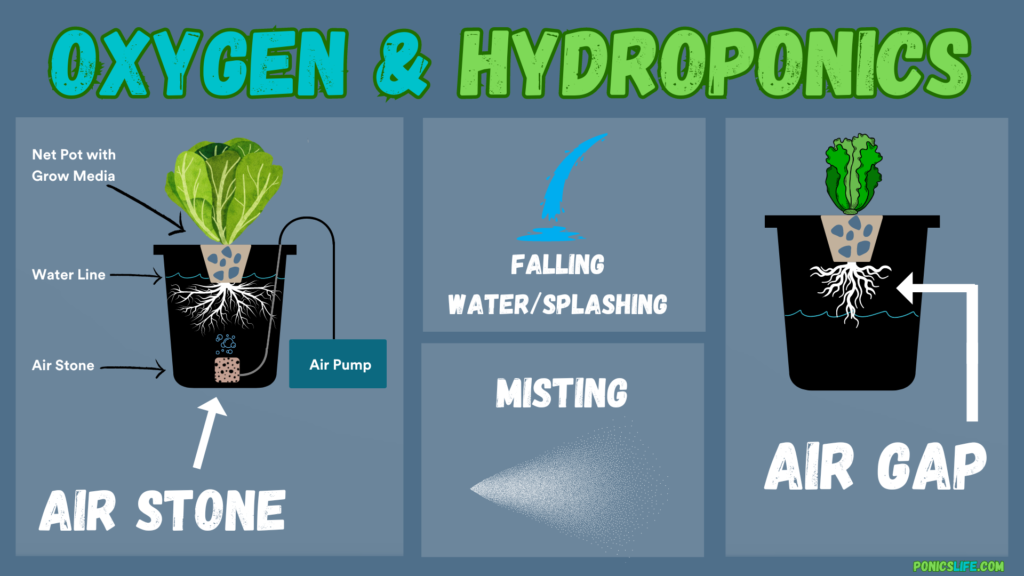
Air Gap
An air gap method is simplicity at its best, creating a space between the plant roots and the nutrient solution. This gap allows roots to access oxygen directly from the air. The air gap technique is commonly employed in systems such as the Kratky method or certain types of deep water culture (DWC), where the root tips are submerged, and the upper portion remains exposed to air. This method is particularly advantageous for its simplicity and low maintenance, requiring no electricity or moving parts. However, its effectiveness can be limited by the system’s design and the environmental conditions. It’s important to note that most hydroponic systems/designs utilize an air gap to some degree.
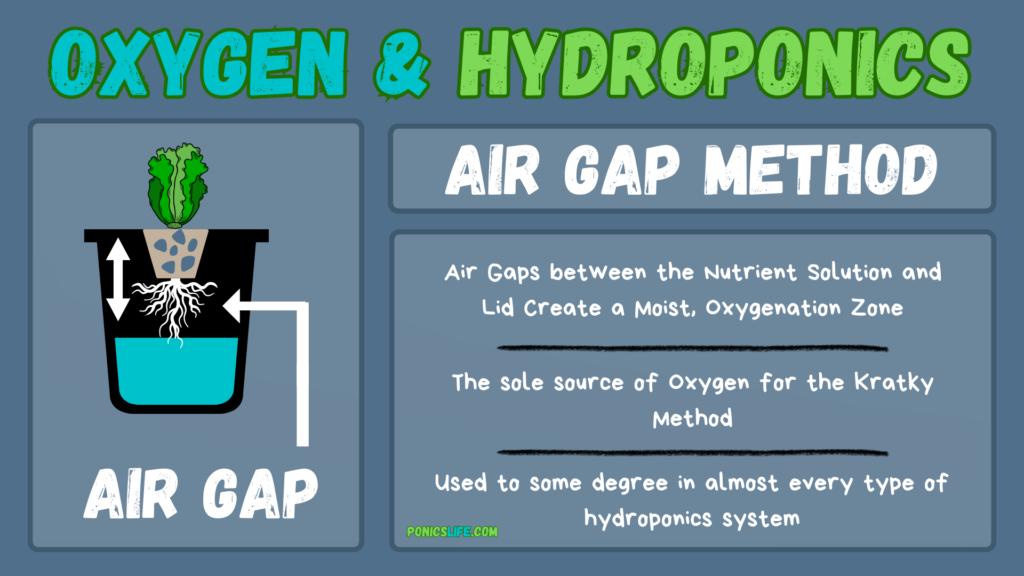
Air Pump and Air Stone
The use of an air pump and air stone is among the most popular oxygenation techniques in hydroponics. An air pump pushes air through an air stone submerged in the nutrient solution, creating a stream of fine bubbles. This process not only delivers oxygen directly to the roots but also promotes nutrient circulation within the reservoir. The effectiveness of this method can be adjusted by varying the pump’s power and the size or number of air stones, making it suitable for systems of all sizes.

Falling Water/Splashing
Falling water, or the act of allowing water to splash, naturally incorporates oxygen into the nutrient solution. This can be achieved through techniques such as using a waterfall, a fountain, or simply positioning the return lines above the water level to create a splashing effect. The agitation and surface disturbance increase gas exchange, which enriches the water with oxygen. This method is especially beneficial in systems with recirculating nutrient solutions, such as the NFT (Nutrient Film Technique) and some tower systems.
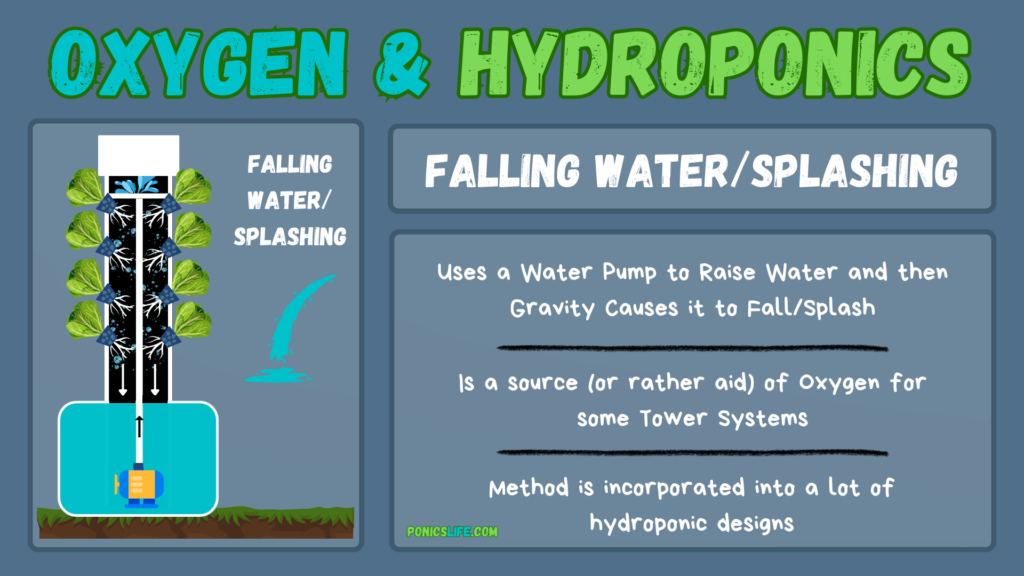
Misting
Misting systems, aka aeroponic setups, deliver oxygen and nutrients by spraying a fine mist directly onto the roots. This method ensures that the roots are exposed to air and nutrient solution simultaneously, maximizing oxygen absorption. Misting can lead to rapid growth and high oxygen efficiency but requires precise control over the misting cycle and droplet size to prevent root suffocation or drying out.
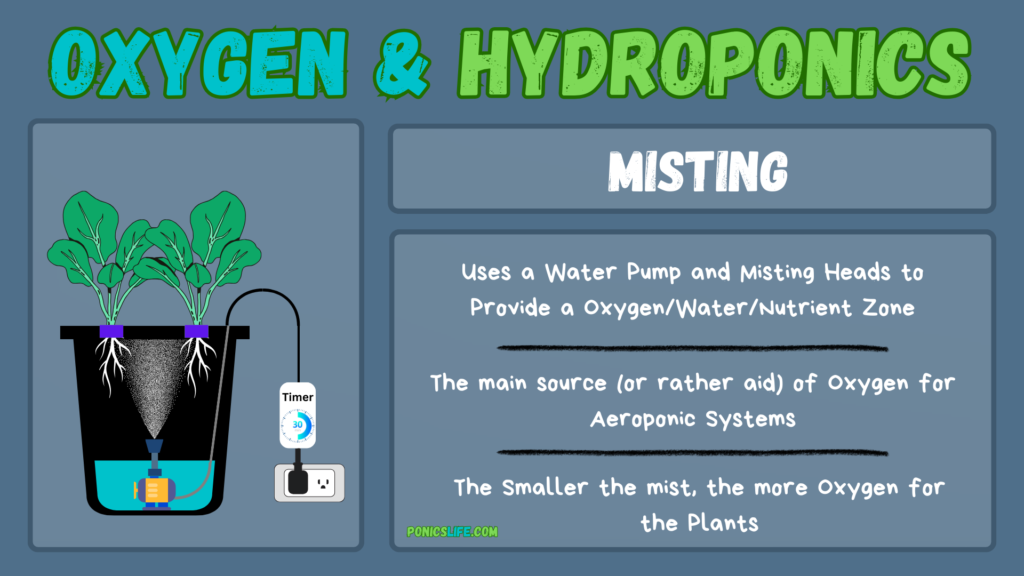
Venturi Effect
The Venturi effect utilizes a change in fluid pressure to draw air into the water as it flows through a constricted section of pipe. By installing a Venturi injector in the system’s water line, air is naturally sucked into the water stream, enriching it with oxygen without the need for additional equipment like air pumps. While more common in aquaponic systems, this method is highly efficient and can be integrated into many hydroponic systems with minimal adjustments.
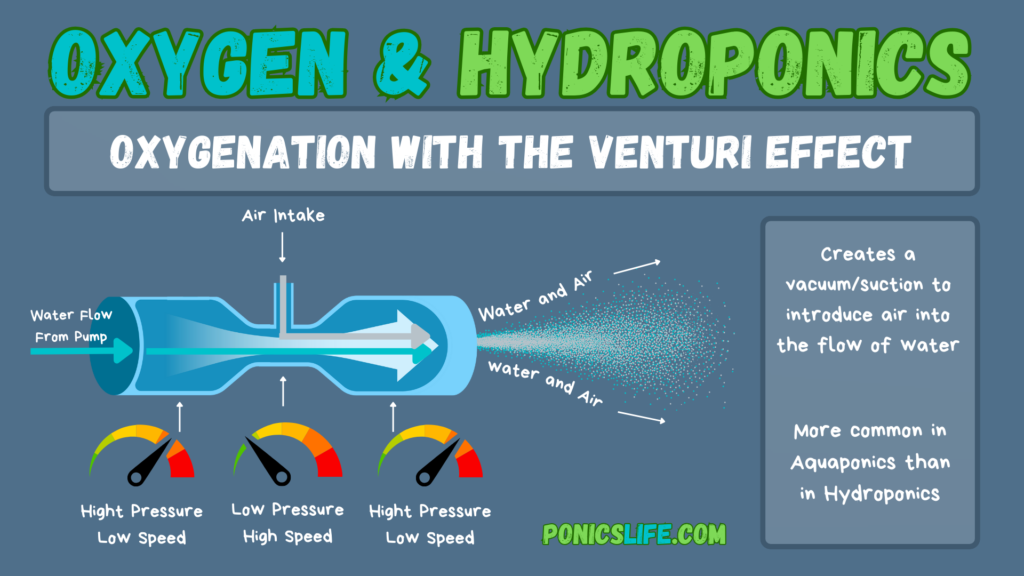
How Much Oxygen Do You Need?
Determining the precise amount of oxygen your hydroponic system requires involves considering several factors, including the size of your reservoir and the specific hydroponic setup being used.
For hobbyists, however, whether growing herbs (considered easy) or tomatoes (considered a little more difficult), there really isn’t a thing as too much oxygen. The more oxygen you supply, the happier your plants will be.
However, if you are looking to get a more precise measurement, you can always use a Dissolved Oxygen Meter (DO Meter) to find specifics. Generally, a dissolved oxygen level between 5 to 8 mg/L (parts per million or ppm) is considered ideal for most hydroponic setups. However, higher levels, up to 20 ppm, can further enhance plant growth and resilience against root diseases. It’s essential to monitor oxygen levels regularly using a dissolved oxygen meter to ensure optimal conditions for your plants.
Maximizing Oxygen Absorption
To maximize oxygen absorption, it’s not just about introducing oxygen into the system but ensuring the roots can effectively utilize it. Regularly cleaning your system, maintaining the right water temperature (oxygen dissolves better in cooler water), and ensuring proper circulation are critical steps. A temperature range of 18°C to 22°C (64°F to 72°F) is typically recommended for most hydroponic systems to maintain high dissolved oxygen levels.
Oxygenation Challenges and Solutions
While introducing oxygen into your hydroponic system might seem straightforward, challenges can arise. For example, high temperatures can decrease oxygen solubility in water, and overcrowded plants can lead to uneven oxygen distribution. Address these challenges by employing cooling mechanisms during hot periods, spacing plants appropriately, and regularly checking and adjusting your oxygenation methods as necessary.
Innovative Oxygenation Techniques
Beyond the traditional methods, innovative techniques such as electrochemical oxygenation are being explored. These advanced methods promise even higher levels of dissolved oxygen, offering exciting possibilities for enhancing plant growth and system efficiency.
The Role of Oxygen in Plant Nutrition
Oxygen is crucial not just for respiration but also plays a vital role in nutrient uptake. Oxygen at the root zone helps convert nutrients into forms that are more easily absorbed by plants, facilitating efficient nutrient uptake and promoting healthier, more robust growth.
FAQs
What are the signs of low oxygen levels in my hydroponic system?
Signs of low oxygen levels include drooping (most common first sign), slow plant growth, and a susceptibility to root diseases like root rot. If you notice these symptoms, assess and adjust your oxygenation methods promptly.
How often should I check the oxygen levels in my hydroponic system?
Regularly checking oxygen levels every few days is advisable to ensure your plants are getting what they need.
What’s the best way to inspect oxygen levels?
While you can use DO meters, the easiest and most affordable way to see how much oxygen is in your system is to visually inspect it. If you see oxygen flowing throughout your reservoir and your plants look happy, then you’re probably ok. If they start to droop, increase oxygenation (more air stones, bigger air pump, or a combination of strategies listed above).
Can I use multiple oxygenation methods simultaneously?
Yes, using multiple oxygenation methods can be beneficial, especially in larger or more complex systems. Combining methods can help ensure a more uniform and consistent oxygen supply to all plants.
How can I increase oxygen levels in my hydroponic system without additional equipment?
Increasing water movement and ensuring a cooler water temperature can help increase dissolved oxygen levels. Additionally, regular system maintenance to prevent root crowding and debris buildup can improve oxygen availability.






